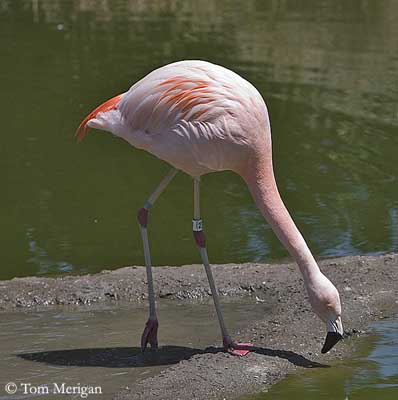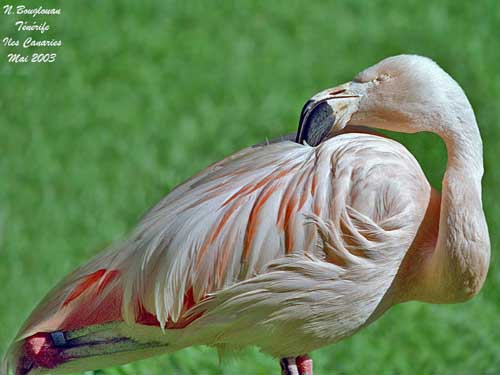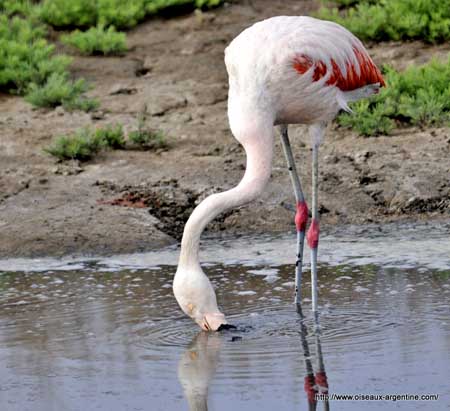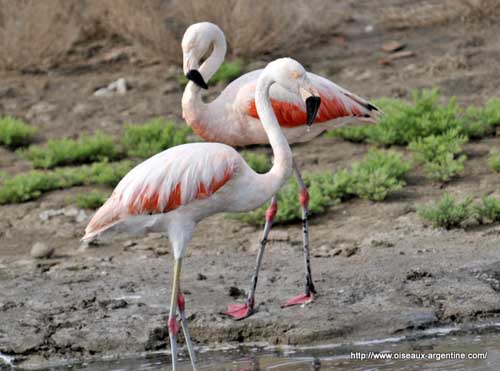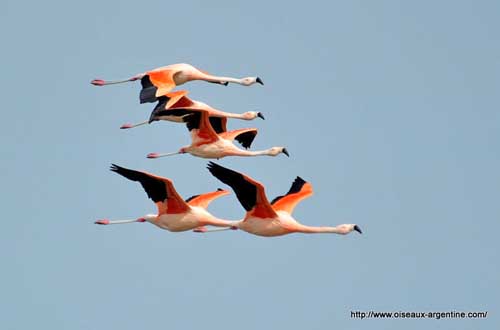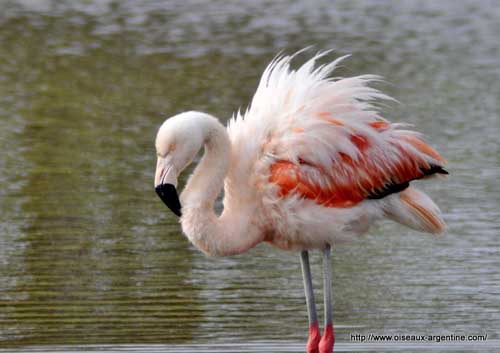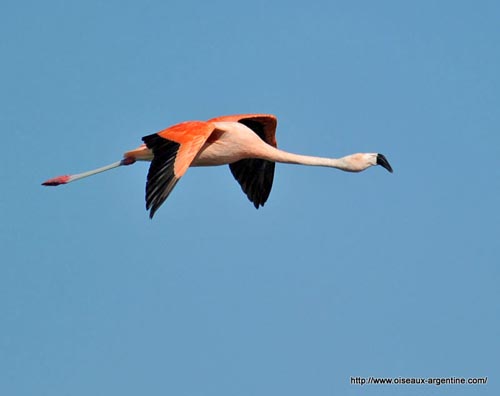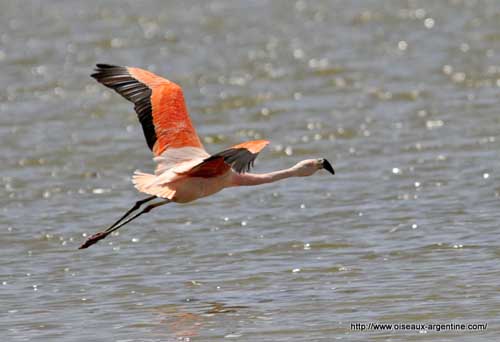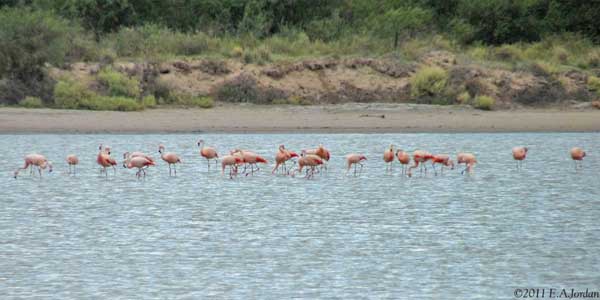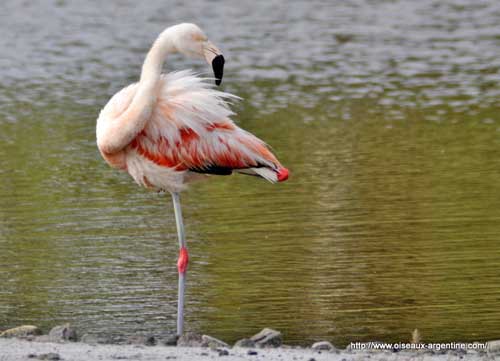
Chilean Flamingo
Phoenicopterus chilensis
Phoenicopteriforme Order – Phoenicopteridae Family
BIOMETRICS:
Height : 80cm
Wingspan : 95 à 100 cm
Weight : 2500 g
LONGEVITY: Up to 30 years in wild, and 50 years in captivity.
DESCRIPTION:
Chilean Flamingo is smaller and paler than the other flamingos. Flamingos have an elongated sinuous neck, short tail and long wingspan. Toes are short and webbed; legs are naked, with heel and feet being pink. Legs are yellowish grey with red “knees” and feet, though the “knees” are really carpel joints and bend both ways.
Fr: Flamant du Chili
Esp : Flamenco Chileno
Ital: Fenicottero del Cile
Nd: Chileense Flamingo
Russe: Чилийский фламинго
Sd: Chileflamingo
Eduardo Andrés Jordan
MIS AVES – AVES DE ARGENTINA
Tom Merigan
Tom Meriganís Photo Galleries
Philippe and Aline Wolfer
OISEAUX D'ARGENTINE
Nicole Bouglouan
PHOTOGRAPHIC RAMBLE
Text by Nicole Bouglouan
Sources:
HANDBOOK OF THE BIRDS OF THE WORLD vol 1 by Josep del Hoyo-Andrew Elliot-Jordi Sargatal - Lynx Edicions - ISBN: 8487334105
Welcome to WhoZoo (Jill Foley)

Bill is black and adapted for its unique feeding method: it is held upside down in the water, and swept back and forth, so the tiny organisms are filtered out. Bill is bent sharply downward with filtering structure; the upper jaw fits into the lower jaw like a box lid. The fleshy tongue works to and fro like a piston. Tongue is covered with bristle like projections that help to filter water and food particles through the lamellae.
Chilean flamingo has a pale white pink plumage. Wings are pinkish, with black tips on primaries and secondaries, very conspicuous in flight.
Male is slightly larger than female, but both sexes are similar.
Juvenile has grey-brown plumage with white belly, grey bill with black tip, and blackish legs and feet.
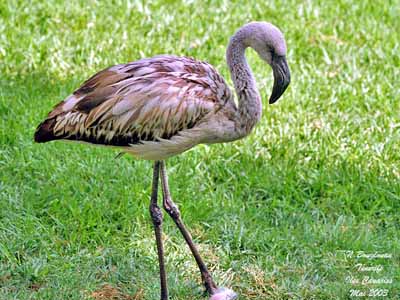
VOICE: SOUNDS BY XENO-CANTO
Chilean flamingo’s voice is loud and rather goose-like, and appears to be important in keeping the flock together when flying.
HABITAT:
Chilean flamingos are found in sea coasts, salt and freshwater lakes, from the sea level to high elevation, 4500 metres and even more. It lives in shallow water, usually in warmer climates.
RANGE:
Chilean flamingos are found in the Andes Mountains in Peru, Chile, Argentina and Bolivia and south along the Andes to Tierra de Fuego. In lowlands, we can find it in Brazil, Uruguay and Falklands.
BEHAVIOUR:
Chilean Flamingo is the most numerous and widespread flamingo in South America. Flocks may range in numbers from a few individuals to tens of thousands.
Chilean flamingo is a filter-feeder. Beak serves as a strainer filtering mud and water out, while trapping little unicellular creatures.
Flamingos are able to swim as well as fly. They are migratory.
Flamingos spend most of the day preening, using the bill to distribute oil from a gland at the base of their tail to their feathers for waterproofing, resting and bathing. They swim readily and bathe in shallow fresh water submerging the whole body.
Flamingos are very social when assembled in nesting areas, and nests are usually built two nest-lengths apart.
They appear to be monogamous, and nest in huge colonies, rarely less than 20 birds.
During courtship, both sexes participate in many displays, such as “head-flagging” followed by “wing-saluting” similar to everyday preening and stretching. These displays occur months before and after actual nesting, and during nesting too.
“Head flagging” involves stretching neck and head up as high as possible with bill pointed upwards, and then rhythmically turning the head from one side to the other.
“Wing saluting” is performed by spreading the wings for a few seconds, showing their strikingly contrasted colours, while the tail is cooked and neck outstretched.
“Twist preening” entails the bird twisting its neck back and appearing to preen quickly, with its bill behind a partly open wing.
“Marching” shows the large, tightly packed flock walks together as one, before switching direction abruptly.
They appear to be monogamous for a season, and breed in huge colonies, seldom smaller than 20 birds.
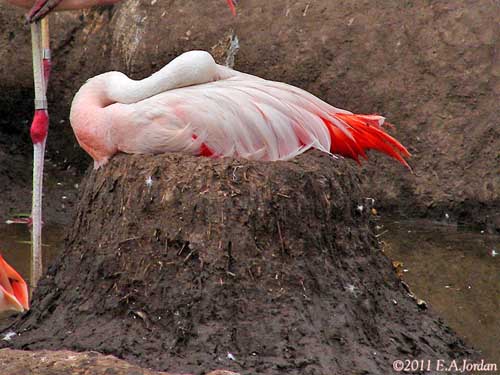
FLIGHT:
Chilean flamingo is a good flier. It flies with stretched neck forward, and legs backward, giving it a typical posture. They fly in “skeins” or “V” formations.
REPRODUCTION:
Chilean flamingos nest in isolated lagoons, with shallow water.
Nest is built by both parents in muddy areas where the mud is scooped and piled into a mound about 15 inches in diameter and 12 inches high, and defended with various threat postures. Mounds serve as protection against the extreme heat and flooding that occurs at ground level.
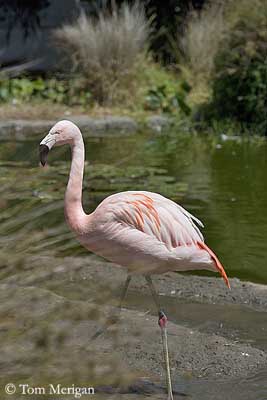
Female lays one white egg. Incubation lasts about 30 days. Young hatches with a grey down covering, and stays 5 to 12 days at nest. During this period, it is fed with “milk”, a secretion from the crop, a poached enlargement of the gullet.
The young is precocial and is fed until approximately three months of age. To keep warm, chick snuggles under the wing of a parent.
Flamingos lose their grey juvenile colour at two years. But they become sexually mature at six years. They can produce two broods per season.
DIET:
Chilean flamingos get their beautiful orange-pink colour from the crustaceans they eat. They also feed on aquatic plants, and tiny animals which live in the mudflats, algae and unicellular organisms.
